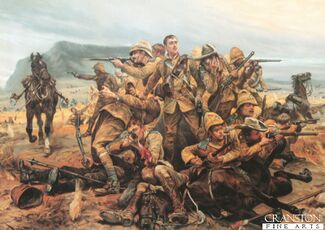Vozhsk War of Independence
| Vozhsk War of Independence | |||||||
|---|---|---|---|---|---|---|---|
| Part of the Voshan Wars | |||||||
 Battle of Driefontein | |||||||
| |||||||
| Belligerents | |||||||
| |||||||
| Commanders and leaders | |||||||
|
| ||||||
| Strength | |||||||
|
Atmoran: 348,000 Dominion/Colonial Forces: 235,000 |
Vozhsk National Army: 289,000 Islamic Republican Guard: 63,000 Aravean Expeditionary Forces 70,000 Foreign Volunteers: 2,743 | ||||||
| Casualties and losses | |||||||
|
37,900 killed 21,600 returned home sick or wounded 41,200 wounded 2,900 missing |
99,570 killed 83,750 wounded 11,950 missing 13,000 captured | ||||||
|
Civilian casualties: 261,000 casualties 66,700 Vozhsk died in concentration camps 183,000 children taken to Atmoran mainland | |||||||
The Vozhsk War of Independence (Dutch: Voshaanse Vrijheidsoorlog; Vozhsk: Vajna za Niezaliežnasć Vozhska ), more commonly known in Atmora as the Second Voshan War (Dutch: Tweede Voshaanse Oorlog; Vozhsk: Druhaja Vozhskaja Vajna ) was the penultimate phase of the Vozhsk national liberation conflict. It was fought between the Atmoran Empire and the Vozhsk Democratic Federative Republic, backed by international allies. On the Vozhsk side, most combatants were members of underground republican militias, foreign volunteer legions, or expeditionary forces from foreign governments. Against them were the Atmoran Armed Forces, as well as the forces of Atmoran dominions and states in personal union, as well as loyalist Vozhsk constables of the Royal Voshan Police (KVPD). It was an escalation of the 'Smutny', the severe revolutionary nationalist unrest that characterised the period of 1883-1911.
In the summer of 1912, the Atmorans instituted a policy of concentration of the civilian population. Over 1.3 million people were interned during the war, of which nearly 67,000 would never return. In addition, nearly 200,000 Vozhsk children were seized from their parents and taken to orphanages in Atmora. Most would never return to Vozh.
In September of 1913, a ceasefire agreement was reached, in part due to the arrival of an Aravean expeditionary force the previous spring. The post-armistice negotiations eventually led to Treaty of Lechtenstad on November 18, ending the war. This officially ended Atmoran rule in Vozh, with only a handful of sovereign base areas (popularly referred to as 'Treaty Towns') remaining under Atmoran control. However, the young Vozhsk republic proved politically unstable, with an Atmoran prince being named as High King after a reactionary coup in 1916.
Background
In October 1904, Vozhsk republicans of the Peasant-Labour and National parties launched the Autumn Revolution against Atmoran rule. Although the revolutionaries managed to seize Mohilev and several major towns on the island of Luhan, the uprising was crushed within a fortnight. Despite its swift suppression, the rebellion and brutality of the Atmoran reprisal led to wider public support for the Republican cause. Later, the election of August 1910 led to a landslide victory for the newly formed National-Labour Party. After several National-Labour MPs were arrested in Koninginnewolde for refusing to swear an oath of allegiance to the Crown, nearly all Vozhsk Parliamentarians who supported independence refused to take their seats in the People's Council of Vosha (Volksraad) of the Estates of Vosha. These abstentionist MPs founded the Douma Vozha in February 1911. In its first act, it created the 'Vozhsk National Army', a paramilitary recruited from the notoriously labour-oriented peasants and mariners of Vozh.
Course of the war
For the first weeks of its existence, the VNA's primary activities involved raiding Royal Voshan Police and Voshan Army arsenals and barracks in pursuit of weapons and liberating imprisoned Republicans. At the same time, the Douma established a state bureaucracy and won public sentiment. Later in May, the Atmoran authorities in the Voshan Council of State outlawed the Douma and National-Labour Party, escalating the conflict. With this, assassinations of Voshan Army officers became rampant, with 91 Atmoran commissioned officers being reported dead or severely maimed by the 31st. On the 3rd of June, the Douma proclaimed the existence of an independent Democratic Federative Republic of Vozh, signalling the official beginning of the war.
By early 1912, Atmoran authority had collapsed in the highlands of the Protectorate. In response, the civilian government was suspended and a military governor was appointed. Around 5,000 people had been killed then, but the crisis would soon escalate. On the 6th of February, the Governor-General of Vosha, Willem Albert van Grysperre, was assassinated by a suicide bomber near his estate 13 kilometres outside of Zelenov, also resulting in the death of several bodyguards and severely wounding his chauffeur. Later in the day, brutal reprisals by Atmoran Army forces resulted in the deaths of some 700 Vozhski in a series of massacres and summary executions. The next week proved the bloodiest for the Atmoran Army in the entirety of the conflict, with over 3,000 Atmoran officers, infantrymen, collaborators, and civilian support personnel being reported killed or severely injured in a series of bombings, shootings and stabbings. Later, the Voshan Army sacked and burned Klietsk city centre in March. Fighting continued to escalate throughout the year, with 50,000 deaths recorded in this time. This was the peak of violence during the war, with bombings by the VNA and gas attacks or reprisal killings by loyalist forces being a nearly daily occurrence.